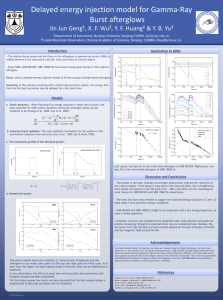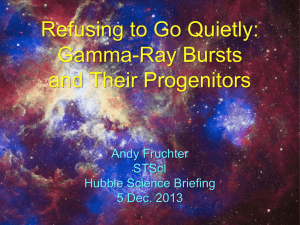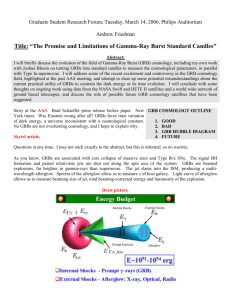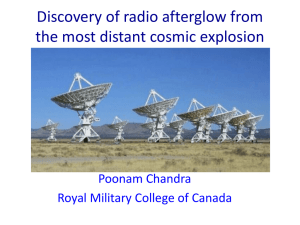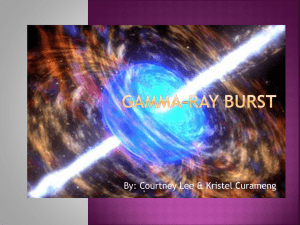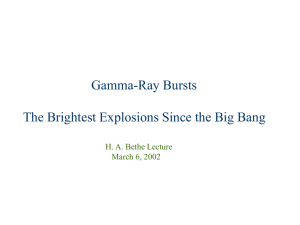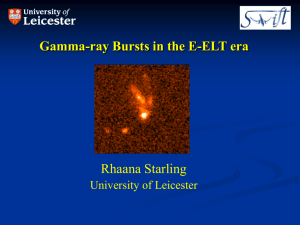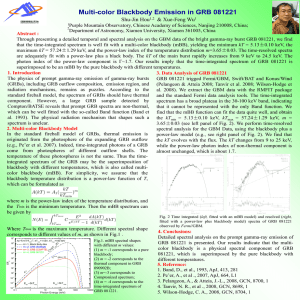Is the plateau emission also a feature of high energy
advertisement
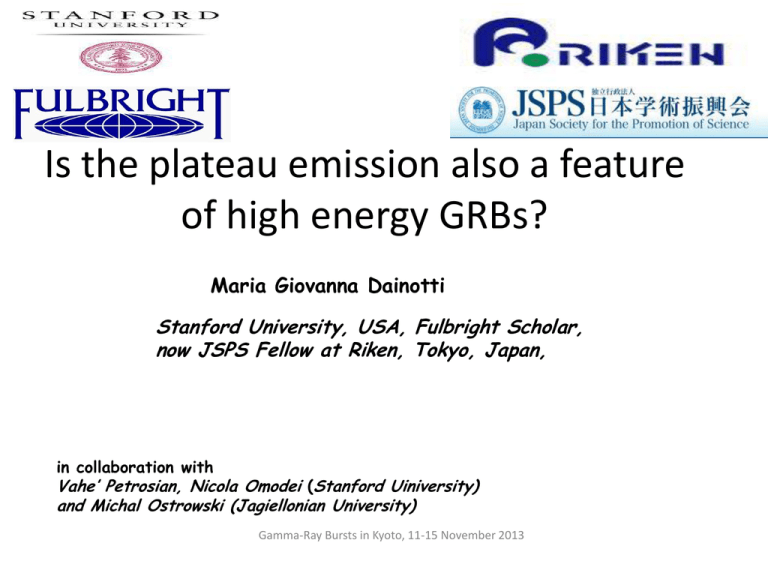
Is the plateau emission also a feature of high energy GRBs? Maria Giovanna Dainotti Stanford University, USA, Fulbright Scholar, now JSPS Fellow at Riken, Tokyo, Japan, in collaboration with Vahe’ Petrosian, Nicola Omodei (Stanford Uiniversity) and Michal Ostrowski (Jagiellonian University) Gamma-Ray Bursts in Kyoto, 11-15 November 2013 Notwithstanding the variety of GRB’s different peculiarities, some common features may be identified looking at their light curves. A breakthrough : • a more complex behavior of the lightcurves, different from the broken power-law assumed in the past (Obrien et al. 2006,Sakamoto et al. 2007). A plateau phase has been discovered. Phenomenological model with SWIFT lightcurves A significant step forward in determining common features in the afterglow • X-ray afterglow lightcurves of the full sample of Swift GRBs shows that they may be fitted by the same analytical expression (Willingale et al. 2007) Gamma-Ray Bursts in Kyoto, 11-15 November 2013 Luminosity-time correlation in X-ray Afterglows This is the last update of previous works: Dainotti, et al. MNRAS, 391, L 79D (2008) Dainotti et al. ApJL, 722, L 215 (2010) The observed correlation slope vs the intrinsic one -1.07 ± 0.14 The observed slope b=-1.27 ± 0.15 After correction of luminosity and time evolution , and luminosity detection bias through the Efron & Petrosian (1999) technique one obtains the intrinsic correlation (Dainotti et al. 2013, ApJ, 774, 157D) Analyzed data sample Sample : 101 afterglows, 90 long, 11 from IC class (short GRBs with extended emission) detected by Swift from January 2005 up to March 2011, namely all the GRBs with good coverage of data that obey to the Willingale et al. 2007 model with firm redshift. Redshifts : from the Greiner's web page http://www.mpe.mpg.de/jcg/grb.html. Redshift range 0.033 <z < 9.2 Spectrum for each GRB was computed during the plateau phase with the Evans et al. 2010 web page http://www.swift.ac.uk/burst_analyser/ This sample serves as a reference for high energy GRBs Prompt-afterglow correlations Dainotti et al., MNRAS, 418,2202, 2011 A search for possible physical relations between the afterglow characteristic luminosity Lx(Ta) and the prompt emission quantities: 1.) the mean luminosity: <L*p>45=Eiso/T*45 2.) <L*p>90=Eiso/T*90 3.) <L*p>Tp=Eiso/T*p 4.) the isotropic energy Eiso From this study we infer that: • La-Ta correlation exists at 12 σ level!!! • It can be useful as a model discriminator among several models that predict the Lx-Ta anti-correlation: • energy injection model from a spinning-down magnetar at the center of the fireball Rowlinson & Obrien (2011), Dall’ Osso et al. (2010), Xu & Huang (2011), Here the correlation is recovered in 1 σ • Accretion model onto the central engine as the long term powerhouse for the X-ray flux Cannizzo & Gerhels (2009), Cannizzo al. 2010. The LT correlation is recovered in 3 σ • Prior emission model for the X-ray plateau LT correlation is recovered in 1 σ Yamazaki (2009) . The • The LT correlation is also recovered for optical data 2009 and Zanonini et al. 2013) et (Ghisellini et al. • For a correct cosmological use we should adopt for a sample the appropriate redshift evolution and to correct it for selection bias ! (see Dainotti et al. 2013b, MNRAS accepted), previous approaches: Cardone et al. 2009,2010 and Postnikov, Dainotti et al. 2013 Gamma-Ray Bursts in Kyoto, 11-15 November 2013 Is there Lx-Ta correlation for LAT GRBs? • First step: we can determine the existence of the plateaus ? • If exists does it depend to a forward shock emission? • From a sample of 35 GRBs (Ackerman et al. 2013, the First Fermi-LAT GRB catalog) we can safely select only 4 GRBs with firm redshift if we consider the fits without upper limits only. • What is the most appropriate method to deal with X-ray and LAT data together? • We show simultaneously the light curves. Gamma-Ray Bursts in Kyoto, 11-15 November 2013 GRB 090510 short hard - a spectroscopic redshift z=0.903±0.003 (Rau et al. 2009) The only case with an overlap between LAT data and XRT at 100 s. Fit: Fp=-3.5,alp=6.34,Tp=0.66,tp=0, Fa=-5.34019, ala=4.35, Ta=1.51,ta=20 reduced 𝜒 2 power law: P=0.02, reduced 𝜒 2 plateau: =0.61 P=0.99 Gamma-Ray Bursts in Kyoto, 11-15 November 2013 Flux into luminosity conversion We tried this approach to see how much the K correction influences the fit. To see this effect we divide each single flux point for its own appropriate K correction using the spectral index associated to that flux. The results both in fluxes and in luminosities do not change. If we consider flaring activity in LAT Then we have possibility to note indication that the evaluated Ta is consistent both for high energy emission and XRT emission. In order to make this indication stronger one can rescale the energy spectra. Gamma-Ray Bursts in Kyoto, 11-15 November 2013 The conversion factor • 10 𝐾𝑒𝑉 −β 𝑑𝐸 𝐸𝐸 0.3 𝑘𝑒𝑉 107 𝐾𝑒𝑉 −β 𝑑𝐸 𝐸𝐸 5 10 𝑘𝑒𝑉 = Conversion factor from LAT to XRT. • The XRT Swift energy band 0.3-10 KeV; LAT band is 100 MeV -1 GeV • Every single point of LAT is multiplied by Conversion factor, where β is the best spectral fit value in the integrated spectrum Gamma-Ray Bursts in Kyoto, 11-15 November 2013 Comparison of the spectral parameters We averaged the spectral parameters in the time interval 100-1000, βmean= -1.87. If we vary the spectral parameter in the indicated circular region (-2.0,-1.5) contemporaneously with the fit parameters of the W07 model we found that the best fit sets of parameters are the ones with the value of βmean. Rescaling of the spectrum In this case we have perfect coverage of the data allowing for a good determination of the end time of the plateau emission Gamma-Ray Bursts in Kyoto, 11-15 November 2013 GRB 080916C: most powerful GRB ever recorded Photometric redshift z=4.35±0.15 (Greiner et al. 2009) Prompt Fp → −6.59, alp → 3.66, Tp → 1.50, tp → 0, Afterglow Fa → −7.76, ala → 2.60, Ta → 2.44, ta → 0 𝜒 2 power law: 3.71 P =6.03×10-6 𝜒 2 plateau: 2.43, P=0.0036 In these two cases the probability is less then 5%, so the plateau doesn’t respect the null hypothesis. Gamma-Ray Bursts in Kyoto, 11-15 November 2013 GRB 090902B: Spectroscopic redshift of z=1.822 based on observations of the optical afterglow using the GMOS spectrograph mounted on the Gemini South Telescope Fp=-5.70,alp=2.38,Tp=1.33,tp=0.,Fa=-7.97,ala=1.26,Ta=2.59,ta=0; 𝜒 2 plateau: 1.53 P=0.14 𝜒 2 power law: 2.82 P=0.00019 In this case the plateau model is favored both by 𝜒 2 and by the null hypothesis Gamma-Ray Bursts in Kyoto, 11-15 November 2013 GRB 090926A: spectroscopic redshift of z = 2.1062 (Malesani et al. 2009). plateau: 𝜒 2 =1.87 P=0.06; power law: 𝜒 2 =4.05 P=1.03×10-6 the plateau model is favored both by and by 𝜒 2 the null hypothesis Gamma-Ray Bursts in Kyoto, 11-15 November 2013 From the analysis of the bursts we have computed the values of the temporal index, α, and combining them with the spectral index β we compute the closure relation, α = (3β − 1)/2, for the plateau phase. We show in which cases the closure relationship are fulfilled. When they are fulfilled there is compatibility with the external shock scenario. GRB name α β α = (3β − 1)/2 GRB 090926 1.02 1.13 Yes GRB 090902B 1.26 1.3 Yes GRB 090510 4.35 1.35 No GRB 080916C 2.60 1.0 No While GRB 090902B is compatible with the explanation of Kumar & Duran 2010, GRB 080916C and GRB 090510 show that the closure relations are not fulfilled. Gamma-Ray Bursts in Kyoto, 11-15 November 2013 Conclusion: Luminosity-Time relations for high energy GRBs Even as the paucity of the data restrains us from drawing any definite conclusion we note similar fitted slopes for L-T correlation, but with different normalizations. L-T correlation seems not to depend on particular energy range: a physical scaling for GRB afterglows both in X-rays and in γ-rays. Normalizations: log a=52.17 in X-rays and 53.40 in γ-rays Gamma-Ray Bursts in Kyoto, 11-15 November 2013
